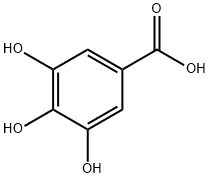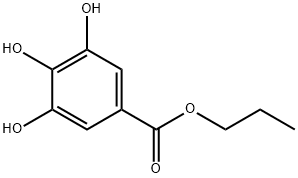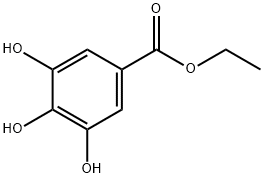Gallicacid , 10mMinDMSO , 149-91-7
Synonym(s):
3,4,5-Trihydroxybenzoic acid;Gallic acid
CAS NO.:149-91-7
Empirical Formula: C7H6O5
Molecular Weight: 170.12
MDL number: MFCD00002510
EINECS: 205-749-9
| Pack Size | Price | Stock | Quantity |
| 1ml | RMB159.20 | In Stock |
|
| others | Enquire |
PRODUCT Properties
| Melting point: | 251 °C (dec.) (lit.) |
| Boiling point: | 259.73°C (rough estimate) |
| Density | 1.694 |
| vapor pressure | 0Pa at 25℃ |
| refractive index | 1.5690 (estimate) |
| storage temp. | 2-8°C |
| solubility | Methanol (Slightly), Water (Slightly, Heated) |
| pka | 4.41(at 25℃) |
| form | Powder |
| color | Off-white |
| PH | 3.75(1 mM solution);3.22(10 mM solution);2.71(100 mM solution) |
| biological source | plant fruit |
| Water Solubility | 12 g/L cold water |
| Merck | 14,4345 |
| BRN | 2050274 |
| Stability: | Stability Stable, but may discolour upon exposure to light. Hygroscopic. Incompatible with strong oxidizing agents, strong bases, acid chlorides, acid anhydrides. |
| InChIKey | LNTHITQWFMADLM-UHFFFAOYSA-N |
| LogP | 0.7 |
| CAS DataBase Reference | 149-91-7(CAS DataBase Reference) |
| NIST Chemistry Reference | Benzoic acid, 3,4,5-trihydroxy-(149-91-7) |
| EPA Substance Registry System | Gallic acid (149-91-7) |
Description and Uses
Gallic acid is a trihydroxybenzoic acid, a type of phenolic acid, a type of organic acid, also known as 3,4,5- trihydroxy benzoic acid, found in gallnuts, sumac, witch hazel, tea leaves, oak bark, and other plants. The chemical formula is C6H2(OH)3COOH. Gallic acid is found both free and as part of hydrolyzable tannins.
Salts and esters of gallic acid are termed 'gallates'. Despite its name, it does not contain gallium.
Gallic acid is commonly used in the pharmaceutical industry. It is used as a standard for determining the phenol content of various analytes by the Folin - Ciocalteau assay; results are reported in gallic acid equivalents. Gallic acid can also be used as a starting material in the synthesis of the psychedelic alkaloid mescaline.
Gallic acid seems to have anti-fungal and antiviral properties. Gallic acid acts as an antioxidant and helps to protect human cells against oxidative damage. Gallic acid was found to show cytotoxicity against cancer cells, without harming healthy cells. Gallic acid is used as a remote astringent in cases of internal haemorrhage. Gallic acid is also used to treat albuminuria and diabetes. Some ointments to treat psoriasis and external haemorrhoids contain gallic acid.
gallic acid is a potential bleaching agent and anti-oxidant, it is also astringent and potentially anti-microbial and anti-fungal. Scientists are finding that gallic acid may serve as a skin-lightening agent by inhibiting the action of the tyrosinase and peroxidase enzymes. Some studies indicate that it is more effective than hydroquinone when combined with the proper ingredients. It is also incorporated into anti-aging formulations for its ability to prevent mucopolysaccaride deterioration. It is a constituent of witch hazel and oak bark, among many other plants; however, it is generally obtained from nutgalls for commercial purposes.
Safety
| Symbol(GHS) |  GHS07 |
| Signal word | Warning |
| Hazard statements | H315-H319-H335 |
| Precautionary statements | P302+P352-P305+P351+P338 |
| Hazard Codes | Xi |
| Risk Statements | 36/37/38 |
| Safety Statements | 26-36-24/25-37/39 |
| WGK Germany | 2 |
| RTECS | LW7525000 |
| F | 8-9-23 |
| TSCA | Yes |
| HS Code | 29182900 |
| Hazardous Substances Data | 149-91-7(Hazardous Substances Data) |
| Toxicity | LD50 in rabbits (g/kg): 5.0 orally (Dollahite) |



